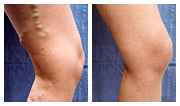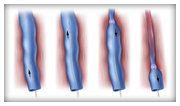What's happening?
Varicose veins can form anywhere in the body, but they are most often located in the legs. In the United States alone, about 20% of men and 50% of women have varicose veins.
Patients who have problem veins will often experience great discomfort caused by the reflux of blood. As the blood is flowing back to the heart through the vein systems, a series of one-way valves stops the blood from flowing backwards. If the valves do not close properly, the blood falls backward through the poorly closing or leaking valves.
The veins now unprotected by valves upstream cannot endure the increasing pressure of the column of flowing blood and expand, becoming snake-like in appearance. The veins bulge through the skin surface and become varicose veins.

The legs often ache and feel heavy and itchy. Severe pain can sometimes occur, and the legs can feel “restless” or cramp at night. |
Treatment
Endovenous Laser Ablation (EVLA) is a procedure that is less invasive than surgery and has a lower complication rate than the vein stripping still practiced by some surgeons. EVLA works by delivering laser energy to the desired location of the damaged vein through a fiber. The fiber is inserted in the vein and then withdrawn until the entire vessel is treated.
Sclerotherapy involves injecting a solution that treats the problem veins. This treatment can applied to larger and smaller varicose veins, commonly called “spider veins.” Sclerotherapy is sometimes used in combination with EVLA.
Finally, another type of laser treatment, a type of phototherapy, can be used to treat the smallest problem veins, which are dilated capillaries. Multiple treatments are often required.

Vein Closure by EVLA |
